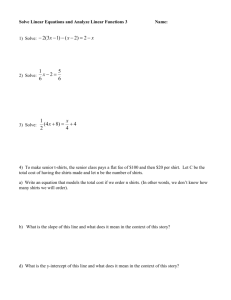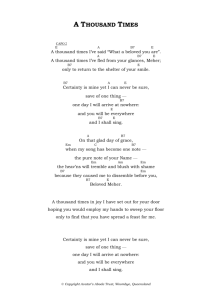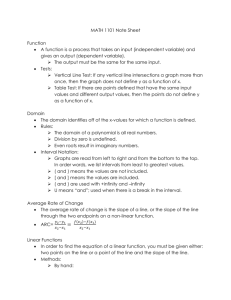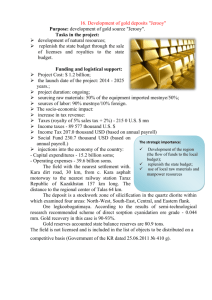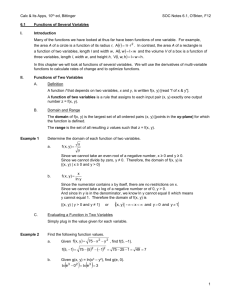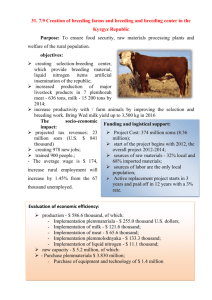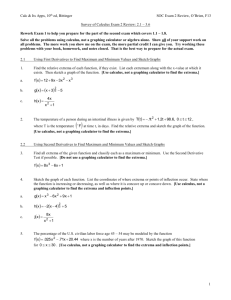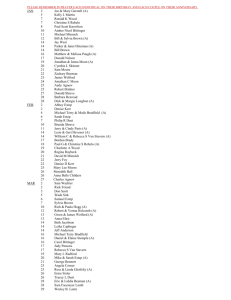SOC 6.3 Notes Bittinger 10th F12
advertisement
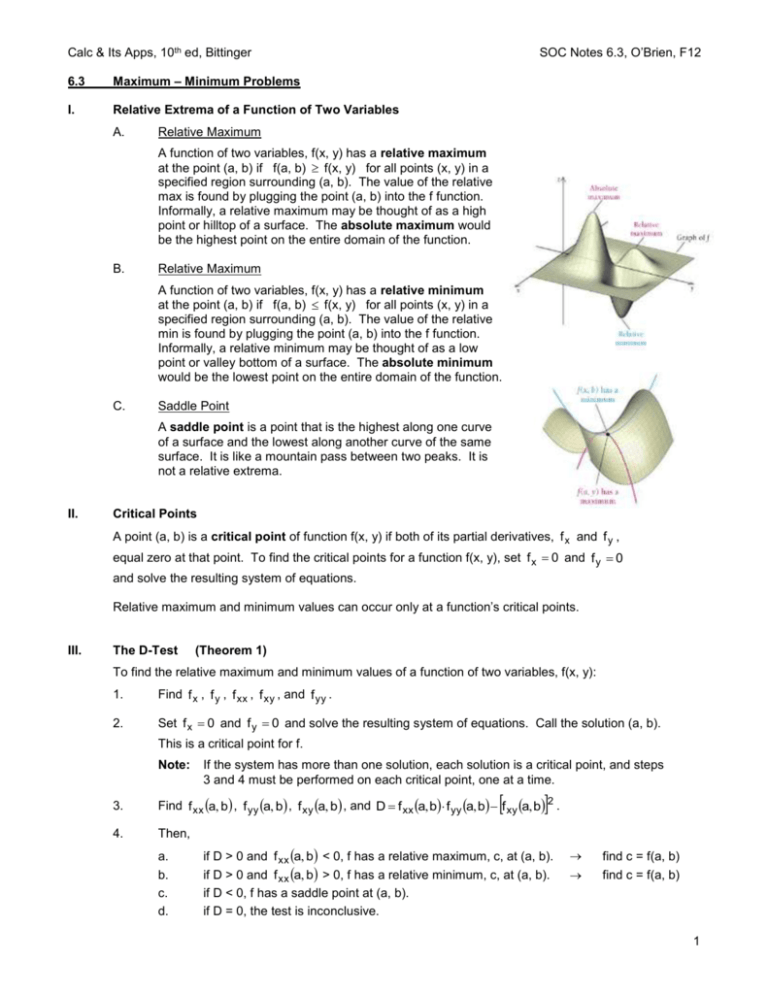
SOC Notes 6.3, O’Brien, F12 Calc & Its Apps, 10th ed, Bittinger 6.3 Maximum – Minimum Problems I. Relative Extrema of a Function of Two Variables A. Relative Maximum A function of two variables, f(x, y) has a relative maximum at the point (a, b) if f(a, b) f(x, y) for all points (x, y) in a specified region surrounding (a, b). The value of the relative max is found by plugging the point (a, b) into the f function. Informally, a relative maximum may be thought of as a high point or hilltop of a surface. The absolute maximum would be the highest point on the entire domain of the function. B. Relative Maximum A function of two variables, f(x, y) has a relative minimum at the point (a, b) if f(a, b) f(x, y) for all points (x, y) in a specified region surrounding (a, b). The value of the relative min is found by plugging the point (a, b) into the f function. Informally, a relative minimum may be thought of as a low point or valley bottom of a surface. The absolute minimum would be the lowest point on the entire domain of the function. C. Saddle Point A saddle point is a point that is the highest along one curve of a surface and the lowest along another curve of the same surface. It is like a mountain pass between two peaks. It is not a relative extrema. II. Critical Points A point (a, b) is a critical point of function f(x, y) if both of its partial derivatives, f x and f y , equal zero at that point. To find the critical points for a function f(x, y), set f x 0 and f y 0 and solve the resulting system of equations. Relative maximum and minimum values can occur only at a function’s critical points. III. The D-Test (Theorem 1) To find the relative maximum and minimum values of a function of two variables, f(x, y): 1. Find f x , f y , f xx , f xy , and f yy . 2. Set f x 0 and f y 0 and solve the resulting system of equations. Call the solution (a, b). This is a critical point for f. Note: If the system has more than one solution, each solution is a critical point, and steps 3 and 4 must be performed on each critical point, one at a time. 3. Find f xx a, b , f yy a, b , f xy a, b , and D f xx a, b f yy a, b f xy a, b 2 . 4. Then, a. b. c. d. if D > 0 and f xx a, b < 0, f has a relative maximum, c, at (a, b). if D > 0 and f xx a, b > 0, f has a relative minimum, c, at (a, b). if D < 0, f has a saddle point at (a, b). if D = 0, the test is inconclusive. find c = f(a, b) find c = f(a, b) 1 SOC Notes 6.3, O’Brien, F12 Calc & Its Apps, 10th ed, Bittinger Example 1: Find the relative maximum and minimum values of f x, y x 2 xy y 2 y . f y x 2y 1 1. f x 2x y 2. 2x + y = 0 x + 2y – 1 = 0 y = –2x x + 2(–2x) – 1 = 0 3. f xy 1 f xx 2 x – 4x = 1 f yy 2 –3x = 1 x 1 3 1 2 1 2 y 2 critical point (a, b): = , 3 3 3 3 Since f xx , f xy , and f yy are all constants, we do not have to plug in our critical point to find f xx a, b , f yy a, b , and f xy a, b . D 2 2 12 4 1 3 4. 1 2 Since D > 0 and f xx a, b > 0, f has a relative minimum at f , . 3 3 2 2 2 1 1 2 1 1 2 2 f , . 3 3 3 3 3 3 3 3 Conclusion: f has a relative minimum of Example 2: 1 1 2 at , 3 3 3 Find the relative maximum and minimum values of f x, y 4xy x 3 y 2 . 1. f x 4y 3x 2 2. 4y 3x 2 0 f y 4x 2y 4x – 2y = 0 2 8 3x 0 8 = 3x 4x = 2y 8x 3x 0 2 4(2x) 3x 0 f xy 4 f xx 6x f yy 2 2x = y x8 3x 0 x=0 8 x 3 8 16 8 16 y 2 critical points: (0, 0) and , 3 3 3 3 Since f xy and f yy are all constants, we do not have to plug in our critical points to find f xy a, b and f yy a, b . However, we do have to find f xx a, b for both y 20 0 3. critical points. For (0, 0), f xx a, b f xx 0, 0 60 0 8 16 8 16 8 For , , f xx a, b f xx , 6 16 3 3 3 3 3 For (0, 0), D 0 2 42 16 . 4. 8 16 For , , D 16 2 42 32 16 16 3 3 Since D < 0 for (0, 0), there is a saddle point at (0, 0). 8 16 8 16 Since D > 0 and f xx a, b 0 for , , there is a relative maximum at , . 3 3 3 3 3 2 8 16 8 256 8 16 16 f , 4 3 3 3 27 3 3 3 Conclusion: f has a relative maximum of 256 8 16 at , . 27 3 3 2 SOC Notes 6.3, O’Brien, F12 Calc & Its Apps, 10th ed, Bittinger Example 3 Maximizing Profit A concert promoter produce two kinds of souvenir shirts: one kind sells for $18, and the other sells for $25. The total revenue, in thousands of dollars, from the sale of x thousand shirts at $18 each and y thousand shirts at $25 each is given by Rx, y 18 x 25 y The company determines that the total cost, in thousands of dollars, of producing x thousand of the $18 shirt and y thousand of the $25 shirt is given by Cx, y 4x 2 6xy 3y 2 20 x 19 y 12 . How many of each type of shirt must be produced and sold in order to maximize profit? What is the maximum profit? Since profit = revenue – cost, Px, y 18 x 25 y 4x 2 6xy 3y 2 20 x 19 y 12 Px, y 18 x 25 y 4x 2 6xy 3y 2 20 x 19 y 12 Px, y 4x 2 6xy 3y 2 2x 6y 12 Py 6x 6y 6 1. Px 8x 6y 2 2. –8x + 6y – 2 = 0 6x – 6y + 6 = 0 8x 6y 2 6x 6y 6 8x 6x 1 2 x=2 3. y=2+1=3 8 x 6 x 6 2 Pxx 8 6y 6x 6 2x 4 Pxy 6 Pyy 6 y x 1 critical point: (2, 3) Since f xx , f xy , and f yy are all constants, we do not have to plug in our critical point to find f xx a, b , f yy a, b , and f xy a, b . D 8 6 62 = 48 – 36 = 12 4. Since D > 0 and Pxx 0 , P has a relative maximum at (2, 3) P2,3 422 6 2 3 332 22 63 12 = 19 Conclusion: A maximum profit of $19,000 will be earned if 2 thousand $18 shirts and 3 thousand $25 shirts are produced and sold. 3
